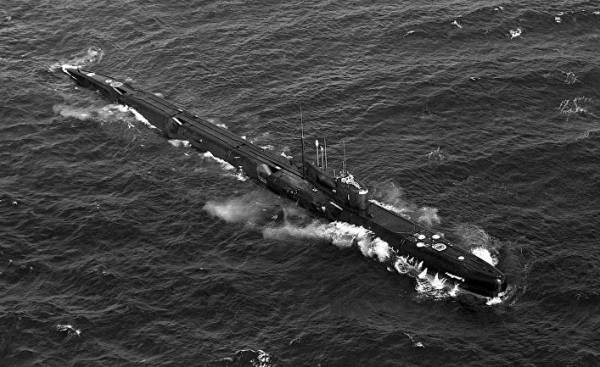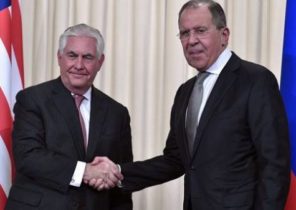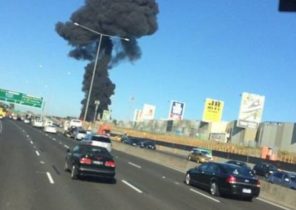
The explosion tore a 12-ton cover of the reactor, was ejected fuel elements and tore a durable case. The reactor core was destroyed, and near eight officers and two sailors were killed instantly. The explosion in the air flew the wreckage, a plume of radioactive fallout with a width of 650 metres, blown by the wind around the Peninsula to the Danube for three and a half kilometers. Radioactive precipitation and isotope cobalt-60 has also fallen overboard and in the nearby docks.
In 1985 a Soviet submarine was very delicate work on the recharge of the active zones of reactors. By coincidence, accident, which killed 10 sailors. The fuel was nuclear, the disaster happened a dangerous and long lasting radioactive contamination. The incident was kept secret until the collapse of the USSR, became one of the many nuclear accidents in the Soviet Navy during the cold war.
Soviet military strategists was very difficult to prepare attacks on the United States. If the United States was almost surrounded by a great socialist country with nuclear missiles, placing them in countries such as Japan and Turkey, the Soviets could not in response to deploy similar weapons in the Western hemisphere.
In this regard, the designers engaged in the creation of nuclear submarines with cruise missiles. These submarines of project 659 and 675 was equipped with six and eight nuclear cruise missiles P-5 class “spaceship-earth”. P-5 (“Five”) was a subsonic missile with a range of 500 kilometers and a warhead of 200 or 350 kilotons. Circular error probable P-5 was three kilometers, that is, within these limits was to fall half launched missiles, and the second half could have landed much further.
Missiles were stored in large horizontal containers along the deck of the boat. To launch missiles P-5 submarine was surfaced, deployed and activated a radar maintenance, then restore the data transmitted to the missile while it was flying at high altitude. This system was imperfect because the command channel is not protected from jamming, and the boat had to remain on the surface as long as the missile did not reach the goal. She was defenseless against patrol aircraft and warships of the enemy. Over time, the P-5 was removed from service and replaced by the missile P-6. It was similar to the predecessor, but had a radar homing head, and could strike at us aircraft carriers.
With the advent of N-6 submarine of project 675 has received a new lease of life. By 1985, the submarine K-431 has served for 20 years, but was still technically sound. Like other boats of this project, it had two pressurized-water reactor that powered a steam turbine, creating a traction force of 60 thousand horsepower. The boat was old, and the stock of nuclear fuel needed to refill. By early August, the recharging process of the active zones of the reactors began at the shipyard of the Navy in the Bay of Chazhma.
August 10, work was carried out on fuel. According to available information, the lid of the reactor with new fuel rods are lifted up. On the cover put I-beam, so it does not rise above, but because of the inept actions of the officers of the rods up in the air too high. (According to another version, this time passing by a torpedo boat, which raised a wave, and that boat rocked, and the shafts has risen too high.) As a result, the reactor port side has reached critical mass, went to the start-up mode, and this caused a chain reaction and explosion.
The explosion tore a 12-ton cover of the reactor, was ejected fuel elements and tore a durable case. The reactor core was destroyed, and near eight officers and two sailors were killed instantly. The explosion in the air flew the wreckage, a plume of radioactive fallout with a width of 650 metres, blown by the wind around the Peninsula to the Danube for three and a half kilometers. Radioactive precipitation and isotope cobalt-60 has also fallen overboard and in the nearby docks.
According to the Nuclear Risks, the accident site was subjected to a powerful radiation. Gamma radiation wasn’t so bad. Dose radiation to five millisieverts per hour, which is equivalent to computed tomography of the chest conducted every hour. But because of the explosion in the air soared 259 petabecquerels radioactive particles, including 29 gigabecquerels iodine-131, which causes cancer. This did not Bode well emergency workers, especially firefighters, who were forced to work on the site of the explosion, and residents of nearby village of Shkotovo-22. 59 team members on elimination of consequences of having symptoms of radiation sickness, and at ten was recorded on the acute form.
Plus this incident was that the fuel rods were new, not old, and therefore wasn’t there in a large number of dangerous isotopes of the type of strontium-90 and cesium-137 as an accident at a nuclear power plant. Bukhta Chazhma contaminated to this day, but experts don’t know to what extent this is a result of the accident, K-431, in which the contamination caused by abandoned and neglected in the area of nuclear submarines.
Crash K-431 was one of several incidents with Soviet reactors on submarines. The accident of a nuclear reactor took place on 10 Soviet submarines, and K-11 state of emergency happened also when recharging active zones. In the nuclear submarine fleet of the United States, unlike the USSR, there was not a single accident of a nuclear reactor, and not only in the cold war era, but also later, up to the present day. The frequency of incidents is of particular concern due to the fact that the loss of the boat or the crew due to a reactor accident may unintentionally lead to a military crisis between Washington and Moscow. And as tensions between the two countries begins to reach the level of the cold war, accidents like the one that occurred on K-431, serve as an important reminder that the situation can sometimes get out of control, in connection with sound minds and cool heads should always prevail.
Kyle Mizokami is a specialist in the field of defense and national security. Lives and works in San Francisco, and his articles are published in such publications as the Diplomat, Foreign Policy, War is Boring and the Daily Beast. In 2009, he became one of the founders of the blog Japan Security Watch.







